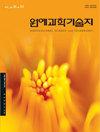微酸性电解水对月季切花灰霉病菌的抑菌作用
IF 0.8
4区 农林科学
Q3 HORTICULTURE
Korean Journal of Horticultural Science & Technology
Pub Date : 2023-06-30
DOI:10.7235/hort.20230028
引用次数: 1
摘要
本研究调查了微酸性电解水对葡萄灰霉病的抗真菌作用,葡萄灰霉病是一种导致“泡泡糖”玫瑰切花上出现灰色霉菌的物质。接种花瓣时喷洒孢子悬浮液,浓度为3 × 105孢子·mL-1(每朵花1.2 mL),晾干1小时。本研究采用的花瓣脉冲处理为:不处理(NT、对照)和浓度分别为0、5、10、20和30µL·L-1的HOCl处理,喷3秒。与NT(94.6%)相比,30µL·L-1 HOCl处理(27.8%)减少了71%,与0µL·L-1 HOCl处理(87.9%)相比,减少了68%。切花玫瑰的花瓶寿命在华北地区最低,在30µL·L-1 HOCl浓度下最高。随着HOCl浓度的升高,灰绿芽孢杆菌的发病率呈下降趋势。除NT值与采后处理前相比外,各处理间花瓣颜色在L*、a*和b*值上均无差异。与第0天相比,用ΔE*值测量的花瓣颜色变化率最高,并且在HOCl处理中花瓣颜色保持不变的程度最大。花瓣电解液渗漏量以NT组最高,HOCl处理后花瓣组织无损伤。开花率在华北地区最低,各处理间差异不大。叶片叶绿素含量、Fv/Fm和气孔大小变化率在不同处理间无显著差异,说明叶片质量未受影响。因此,建议在采后储存前立即用微酸性电解水进行花瓣脉冲处理,以30µL·L-1 HOCl抑制玫瑰切花上的灰霉病。这种处理没有对花瓣或叶子造成任何明显的损害。本文章由计算机程序翻译,如有差异,请以英文原文为准。
Antimicrobial Effect of Slightly Acidic Electrolyzed (HOCl) Water on Botrytis cinerea of Cut Rose Flowers
This study investigates the antifungal effect of slightly acidic electrolyzed water on Botrytis cinerea, an agent that causes gray mold to appear on the cut rose flower of the type known as ‘Bubble Gum’. Petals were inoculated by spraying a spore suspension with 3 × 105 spores·mL-1 (1.2 mL per flower) which was then allowed to dry in air for an hour. The petal pulsing treatments used here were as follows: no treatment (NT, control) and HOCl treatments at concentrations of 0, 5, 10, 20, and 30 µL·L-1 sprayed for three seconds. The treatment with 30 µL·L-1 HOCl (27.8%) reduced B. cinerea by 71% compared to NT (94.6%) and by 68% compared to the 0 µL·L-1 HOCl (87.9%). The vase life of cut rose flowers was lowest in the NT and highest with 30 µL·L-1 HOCl. The disease incidence rate according to the visual index of B. cinerea decreased as the HOCl concentration was increased. The petal color did not differ among the treatments in terms of the L*, a*, and b* values, except for NT compared to the corresponding value before the postharvest treatment. NT showed the highest rate of color change as measured by the ΔE* value compared to 0 days, and the petal color remained unchanged to the greatest degree in the HOCl treatments. Electrolyte leakage from the petals was highest in NT, and there was no petal tissue damage after the HOCl treatments. The flowering rate was lowest in NT, and there were few differences among the treatments. There were no differences among the treatments in terms of the chlorophyll content, Fv/Fm, and stomatal size change rate of the leaf, indicating that the quality of the leaf was not affected. Thus, an immediate petal pulsing treatment with slightly acidic electrolyzed water is recommended to inhibit gray mold on cut rose flowers at 30 µL·L-1 HOCl just before postharvest storage. This treatment did not cause any apparent damage to the petals or leaves.
求助全文
通过发布文献求助,成功后即可免费获取论文全文。
去求助
来源期刊
CiteScore
2.00
自引率
0.00%
发文量
0
审稿时长
1 months
期刊介绍:
Horticultural Science and Technology (abbr. Hortic. Sci. Technol., herein ‘HST’; ISSN, 1226-8763), one of the two official journals of the Korean Society for Horticultural Science (KSHS), was launched in 1998 to provides scientific and professional publication on technology and sciences of horticultural area. As an international journal, HST is published in English and Korean, bimonthly on the last day of even number months, and indexed in ‘SCIE’, ‘SCOPUS’ and ‘CABI’. The HST is devoted for the publication of technical and academic papers and review articles on such arears as cultivation physiology, protected horticulture, postharvest technology, genetics and breeding, tissue culture and biotechnology, and other related to vegetables, fruit, ornamental, and herbal plants.

 求助内容:
求助内容: 应助结果提醒方式:
应助结果提醒方式:


